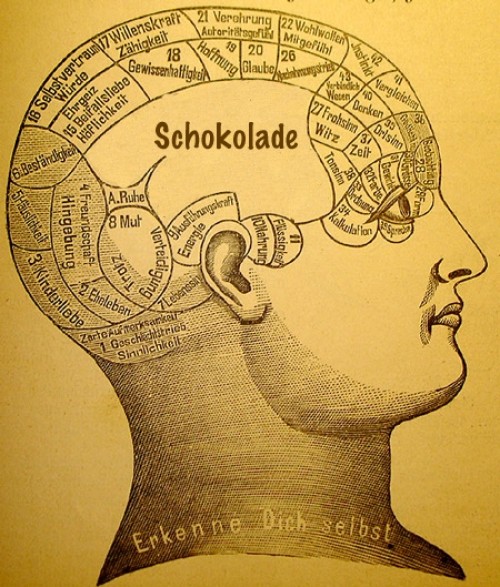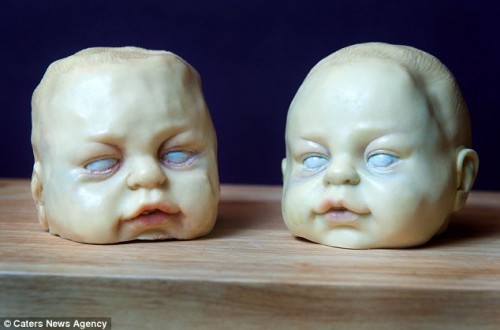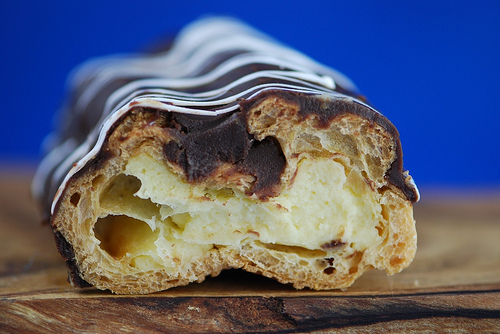Wacky World of Choc Wednesdays: Creepy Chocolate Baby Heads
The world of chocolate, ever wacky, does not disappoint. This week’s story involves a cake artist who “creates edible chocolate baby heads from life-size moulds.” The UK’s Daily Mail has the details.
Chocolate Recipe Roundup
We’ve had a rainy December here in New England, quite different from the dream of a white Christmas that many hold dear. But chocolate always helps to inspire the holiday spirit. Below you’ll find several of my favorite recipes from some of today’s finest (pastry) chefs and chocolatiers. Happy holidays!
Olive Oil Cake
Pastry chef Kim Boyce specializes in baking with whole grains. In this unique recipe, she brings together spelt flour, olive oil, rosemary, and chocolate.
Goat Cheese Souffles
For dramatic flavor effect, pastry chef and chocolatier Michael Recciutti’s recipe pairs goat cheese and cacao nibs.
Espresso and Chocolate Chip Cookies
Chef Rhonda Ruckman’s Twitter feed, featuring photos of her latest pastry creations, often made with Patric Chocolate, is a favorite of mine. This recipe, from her days as proprietor of the now-closed Dallas bakery Doughmonkey, features a classic flavor pairing — dark chocolate and espresso beans — in fudgey cookie form.
Chocolate Thumbprint Cookies
Kathleen King’s thumbprint cookies are soft, chewy, and chocolatey.
Chocolate and Cinnamon Swirl Meringues
This meringue recipe from Annie Rigg tastes like a chocolatey, spicy, crispy on the outside, chewy on the inside sugar cloud.
Chocolate Babka
The Martha Stewart recipe for chocolate babka with cinnamon is sumptuous and buttery. It is an annual star in our household.
Chocolate Soup
A simple list of ingredients for an incredibly sophisticated dessert, from water ganache pioneer Damian Allsop.
And why try only one when you could try three hot chocolate recipes? This year, I am packing the dry ingredients with instructions and gifting them to loved ones.
Aztec-Style Hot Chocolate
British pastry chef and chocolatier Paul A. Young’s spiced hot chocolate recipe is earthy and warm.
Hot Chocolate Agasajo
Chocolate expert and James Beard award-winning chef Maricel Presilla brings together stellar chocolate with a vibrant blend of spices in this unforgettable recipe.
Hot Chocolate with Máchica
This second recipe from Presilla with barley, dark brown sugar, and cinnamon is hearty and satisfying.
Tea tasting with Tea Sommelier Cynthia Gold of L’Espalier
The world of tea is far vaster than we previously imagined. This was the conclusion that Trevor and I reached last Sunday after enjoying our holiday present to ourselves: a tea tasting at the acclaimed L’Espalier restaurant in Boston. Organized and hosted as part of a monthly series by accomplished Tea Sommelier Cynthia Gold, the event was dedicated to the 239th anniversary of the Boston Tea Party (known in its day simply as “the destruction of the tea”). On the menu were five teas – all of which were of the tea varieties that were dumped by the chest into Boston Harbor – and one colonial tea punch. We were tickled to learn that the record of which teas and how many thousands of pounds of each were on board the ship has survived, and it was quite the treat to try their present day incarnations.
Equal parts history lesson and tea tasting/pairing exercise, the event was a perfect combination of delicious fun and tea education. Over the course of two hours, Chef Gold wove together thoughtfully researched historical trivia, detailed notes on each tea, and advice on pairing tea with food.
The teas were, in order:
- China Green Young Hyson, Anhui Province (fun fact #1: It was George Washington’s favorite.)
- Fishhouse Punch, A Colonial Tea Punch
- Gunpowder Green
- Bohea Black, Wuyishan China (fun fact #2: It was Benjamin Franklin’s favorite.)
- China Black Congou, Anhui Province
- Lapsang Souchong
Three of the teas (Gunpowder Green, Bohea Black, and China Black Congou) were also paired with food inspired by colonial New England menus. While the tea, freshly steeped and served in glass stemware, stood out for its simplicity, there was more than enough sugar for an entire holiday season in the form of no fewer than seven distinct desserts. Especially noteworthy were the Brulee Indian Pudding with vanilla Chantilly cream, rum raisin scone, and squash macaròns.
My favorite of the teas was the China Green Young Hyson. A light, smooth, ever-so-slightly grassy green tea harvested “before the rains” in the Anhui province of China, it tasted of the gentle warmth of spring. Trevor and I both agreed that it was a paragon of subtle-tea. [wink] All of the teas, however, taught us something new about the flavor of properly stored and prepared tea as well as our own preferences.
The event menu and Chef Gold’s presentation got me thinking more about pairing tea and chocolate, which is something that I see often in bonbons but less in pairing events like those that involve chocolate and wine or, with growing popularity, chocolate and beer. Many chocolatiers prepare truffles, barks, and bars that bring together dark chocolate and Earl Grey, white chocolate and green tea, or chocolate and chai spices. And even though I tend to eat chocolate on its own, without accompaniment, I would welcome pairings that bring together excellent, well prepared teas with sophisticated, well made bar chocolate. The China Green Young Hyson’s spring-like quality and the gentle handling it receives in harvest and preparation reminded me immediately of Pacari Chocolate’s organic and biodynamic 70% Raw bar. One could also imagine a contrasting pairing of a smoky, meaty Lapsang Souchong with a chocolate bar like Patric Chocolate’s 70% Rio Caribe Superior that tastes of nuts and dried fruit, for example. Or a matched pairing of a jasmine-scented tea with a bar that has delicate, floral notes – the limited edition Rogue Chocolatier Piura bar of my taste memory dreams would be divine. The chocolate decadence cake with matcha sablé that we tasted this Sunday was a start, though muddied by an unremarkable cocoa powder.
Chef Gold’s recommendation for an online tea retail shop: Upton Tea, which also happens to be based in Holliston, MA, just west of Boston. We rushed home to order holiday gifts for some of our favorite tea lovers. I also spent a contented evening reading Chef Gold’s superlative book Culinary Tea, which provides a wonderfully clear introduction to the world of fine tea and over 150 creative recipes for using tea in cooking.
In short, I highly recommend attending a tea tasting at L’Espalier. Trevor and I plan to return soon ourselves. More on the related worlds of chocolate and tea to come.
eat chocolate –> get wicked smaht?

Choco-Phrenology by tychay
After nearly two years of observing the chocolate news cycle, I’ve come to expect that scientific studies linking chocolate with health, wealth, and/or happiness will be widely cited in the media, most often with great enthusiasm and little skepticism. This past week proved no exception, with a study that made for catchy headlines like “Eat chocolate, win the Nobel Prize?,” “Secret to Winning a Nobel Prize? Eat More Chocolate,” and “Chocolate Consumption Directly Related To Nobel Prize Wins, Says New Study.”
These news pieces spread like wildfire through the chocolate world as chocolate companies and afficionados Facebooked and tweeted them with gusto. I often enjoy such stories myself — they can be fun and, hey, any evidence quantifying chocolate’s many virtues is welcome, right? There is a problem with this study’s viral path through the media and the chocolate world, though: its data does not support its claims.
I find it disconcerting that this kind of reporting on this kind of study so often goes unchecked by any broadly available dissenting response. Fortunately, I live with Trevor Bass, an expert on data and its many abuses. His take on the study is below.
—————————————————————————————————————————-
I managed to score last week’s issue of absurdist scientific humor publication The New England Journal of Medicine, which includes a hilarious note on “Chocolate Consumption, Cognitive Function, and Nobel Laureates.” As I continued reading the issue and failed to see the humor in such knee-slappers as “Fibulin-3 as a Blood and Effusion Biomarker for Pleural Mesothelioma” and “Evaluation and Initial Treatment of Supraventricular Tachycardia,” I quickly came to the realization that NEJM is not intended as a satirical magazine. It is, in fact, among the world’s most prestigious peer-reviewed medical journals.
Inspired by recent findings that compounds in chocolate improve cognitive function, cardiologist Franz Messerli’s note questions whether there is “a correlation between between a country’s level of chocolate consumption and its population’s cognitive function.” Using the number of Nobel laureates per capita as a “surrogate end point” for a population’s percentage of wicked smahties, the study finds a “surprisingly powerful correlation between chocolate intake and the number of Nobel laureates in various countries” (23 in all). While he concedes that correlation does not imply causation, Messerli writes “since chocolate consumption has been documented to improve cognitive function, it seems most likely that in a dose-dependent way, chocolate intake provides the abundant fertile ground needed for the sprouting of Nobel laureates.”
Hilarity.
Reportedly, when contacted by the Associated Press, “Sven Lidin, the chairman of the Nobel chemistry prize committee, had not seen the study but was giggling so much when told of it that he could barely comment.”
Indeed, one doesn’t require a doctorate in statistics to find serious flaws in the study. It was clearly intended as tongue-in-cheek to some degree by Messerli (who has according to NPR published around 800 peer reviewed papers) and NEJM (which also according to NPR has a history of occasional tomfoolery), though to what degree I can’t quite ascertain. Scientists’ riotous senses of humor aside, I would have expected dozens of more subtly troubling logical leaps to be followed by winky faces.
Given the absence of sufficient semicolon close parentheses, I worry about the misinformation generated by this study. The media has run wild with it in the past week, citing it widely with often far too little skepticism – an excellent example of a phenomenon I’ve recently started calling quantitative exceptionalism. A comment cardiologist Sanjay Kaul provided to CardioBrief sums up the dangers well: “This article highlights, with a touch of whimsy, caveats that challenge the interpretation of findings of observational studies. From the use of surrogate endpoints (based on biological plausibility and the results of preclinical studies) to the distinction between correlation and causation, confounding (whether the effect size is too large to be explained away by confounding), and the hypothesis-generating nature of the inferential process. Careful consideration of these issues is likely to help navigate through the labyrinth of misinformation and disinformation these types of studies are particularly prone to generating.”
Messerli is no stranger to the harmful effects scientific misinformation can have. Last year, he was quoted in a Wall Street Journal article about mistakes in scientific studies as one of a large number of doctors who (understandably) fell prey to an erroneous paper in the Lancet, another highly respected medical journal. Hundreds of thousands of patients were affected, and Messerli argued that the Lancet had a “moral obligation” to withdraw the paper. Granted, doctors around the world aren’t likely to begin writing prescriptions for dangerously high doses of chocolate based on Messerli’s note in NEJM any time soon, but the difference is one of magnitude rather than direction.
A few examples of things I found more troubling slash hilarious about Messerli’s note:
- The use of the number of Nobel laureates as a surrogate endpoint for cognitive function is…how do I say it?…strange. In fact, the number of Nobel laureates probably has a lot more to do with a country’s wealth. As Nobel laureate Eric Cornell told Reuters, “National chocolate consumption is correlated with a country’s wealth and high-quality research is correlated with a country’s wealth…therefore chocolate is going to be correlated with high-quality research, but there is no causal connection there.”
- Messerli writes: “Obviously, these findings are hypothesis-generating only and will have to be tested in a prospective, randomized trial.” Considering that countries in the study have at most a few Nobel laureates per million population, imagine the enormous expense, financial and otherwise, of such a trial. A properly controlled study would deprive millions of the joys of chocolate.
- While the note warns in multiple places that causation has not been proven, its language repeatedly justifies causation based on tenuous logic. For example, Messerli writes that “it would take about 0.4 kg of chocolate per capita per year to increase the number of Nobel laureates in a given country by 1” and even refers to a “minimally effective chocolate dose.” He justifies such remarks only with references to prior studies linking cacao consumption and cognitive function, which are many leaps-of-faith removed from these conclusions.
- Messerli writes but has no justification for this statement: “it is difficult to identify a plausible common denominator that could possibly drive both chocolate consumption and the number of Nobel laureates over many years. Differences in socioeconomic status from country to country and geographic and climatic factors may play some role, but they fall short of fully explaining the close correlation observed.”
- The study appears to use chocolate rather than flavanol or cacao consumption figures, and the types of chocolate consumed in the studied countries varies significantly. Another gem from Cornell’s interview in Reuters: “It’s one thing if you want like a medicine or chemistry Nobel Prize, ok, but if you want a physics Nobel Prize it pretty much has got to be dark chocolate.” I wonder how considering less economically correlated forms of flavanols like green tea would change the results.
Is Messerli deserving of an Ig Nobel Prize for this gem? According to the Annals of Improbable Research, which awards the prizes annually: “Every Ig Nobel Prize winner has done something that first makes people LAUGH, then makes them THINK.”
Regardless, I’m left wondering what foods predispose you to becoming an Ig Nobel laureate. Foods that leave a funny taste in your mouth? Personally, I’m going to stick with salad.
—————————————————————————————————————————-
Trevor Bass is a quantrepreneur and data scientist who lives in Cambridge, MA. Visit his professional site here to learn more about his work.
Droolworthy chocolate and food studies events calendar
I was green with envy last weekend as tweets and Facebook posts poured in with updates from the Northwest Chocolate Festival in Seattle, WA. While I’ve never attended the festival, the largest gathering of bean-to-bar chocolate makers in the United States, it has been on my wish list since I started blogging. The schedule is packed with what look like excellent events — tastings, lectures, demonstrations, film showings, and just plain fun — many led by experts from the chocolate world. You can view the impressive line-up here [pdf]. Social media allowed many of us to experience the festival vicariously, at least in part. Check out the festival’s Facebook and Twitter pages or watch the trailer below to get a sense for the action.
The social media extravaganza surrounding the festival reminded me of how often I receive queries about chocolate and food events here at the blog. I keep a Google calendar of these events for my own reference and have decided to make it public via the “events” link on the top right of this page. There, you’ll find an ever-growing list of events in the chocolate and food studies world. A heavy emphasis is placed on events in the New England area where I live, but readers who live in other regions can still often find options closer to their own homes. Inclusion of an event on the list does not mean that I endorse the event or that I will attend it myself, but rather that I’ve identified it as a potential site for learning and research worth sharing with a larger audience. I strongly recommend double-checking all details with the hosting institution for each event, as I cannot regularly check for changes related to cancellations, etc, and some events do require entrance fees and/or early registration.
I’ll be working on the events page over the next few weeks to make it even more user friendly, hopefully with a dynamic map to aid in finding events in specific regions. In the meantime, I warmly welcome submissions of event recommendations. To fellow residents of the New England area — we’re fortunate to find ourselves in the midst of an especially vibrant food events scene. If you’re not hungry now, you will be soon!




